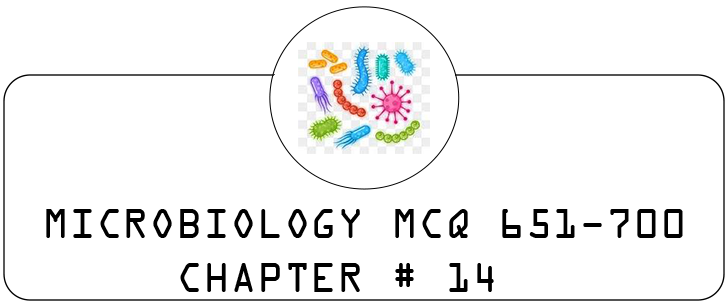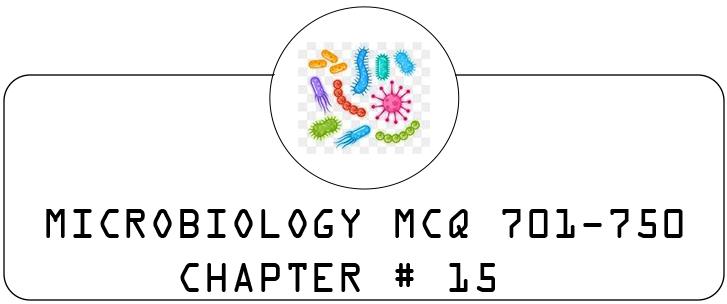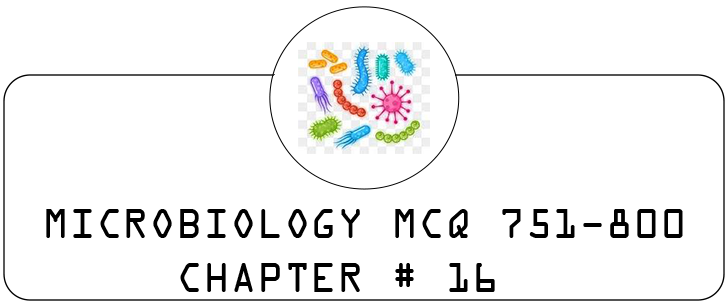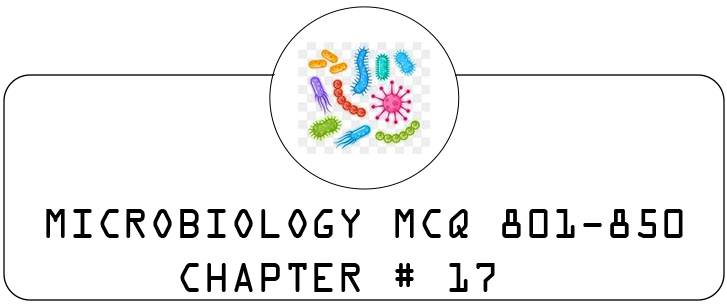601. 20 grams of food sample are mixed with 180 ml of water. What will be the dilution?
A. 10-2
B. 10-1
C. 10-3
D. 10-4 ✅
A. 10-2
B. 10-1
C. 10-3
D. 10-4 ✅
602. Which were the scientist lived at the same time?
A. Koch and Pasteur ✅
B. Darwin and Woese
C. Van Leeuenhoek and Ricketts
D. Berg and Hooke
A. Koch and Pasteur ✅
B. Darwin and Woese
C. Van Leeuenhoek and Ricketts
D. Berg and Hooke
603. The feature of the archaea that distinguishes them from the bacteria is:
A. Habitats which are extreme environments
B. Absence of peptidoglycan in their cell walls ✅
C. Their ribosomal RNA sequences
D. All of the above
A. Habitats which are extreme environments
B. Absence of peptidoglycan in their cell walls ✅
C. Their ribosomal RNA sequences
D. All of the above
604. Which of the following can be used to sterilize heat-labile substances?
A. Autoclaving
B. Dry heat
C. Ethylene oxide ✅
D. Boiling
A. Autoclaving
B. Dry heat
C. Ethylene oxide ✅
D. Boiling
605. The primary stain used in the Gram staining procedure is:
A. Safranin
B. Crystal violet ✅
C. Methylene blue
D. Carbol fuchsin
A. Safranin
B. Crystal violet ✅
C. Methylene blue
D. Carbol fuchsin
606. An example of a Gram-positive bacterium is:
A. Escherichia coli
B. Staphylococcus aureus ✅
C. Salmonella typhi
D. Neisseria gonorrhoeae
A. Escherichia coli
B. Staphylococcus aureus ✅
C. Salmonella typhi
D. Neisseria gonorrhoeae
607. Which of the following is NOT a characteristic of viruses?
A. They are obligate intracellular parasites
B. They have both DNA and RNA ✅
C. They reproduce only within host cells
D. They contain either DNA or RNA
A. They are obligate intracellular parasites
B. They have both DNA and RNA ✅
C. They reproduce only within host cells
D. They contain either DNA or RNA
608. The cytoplasmic membrane of bacteria is primarily made up of:
A. Proteins
B. Lipids ✅
C. Carbohydrates
D. Nucleic acids
A. Proteins
B. Lipids ✅
C. Carbohydrates
D. Nucleic acids
609. Bacteria that are resistant to antibiotics due to the presence of plasmids are known as:
A. Pathogens
B. Mutants
C. Drug-resistant strains ✅
D. Endotoxins
A. Pathogens
B. Mutants
C. Drug-resistant strains ✅
D. Endotoxins
610. The presence of a capsule around a bacterium enhances its:
A. Motility
B. Virulence ✅
C. Growth rate
D. Oxygen requirements
A. Motility
B. Virulence ✅
C. Growth rate
D. Oxygen requirements
611. The main role of the microbiome in human health is to:
A. Cause disease
B. Aid digestion and provide protection ✅
C. Produce toxins
D. Induce allergies
A. Cause disease
B. Aid digestion and provide protection ✅
C. Produce toxins
D. Induce allergies
612. Bacterial endospores are resistant to:
A. Heat
B. Desiccation
C. Chemicals
D. All of the above ✅
A. Heat
B. Desiccation
C. Chemicals
D. All of the above ✅
613. The major site of bacterial infections in humans is:
A. Skin
B. Mucous membranes ✅
C. Blood
D. Bone
A. Skin
B. Mucous membranes ✅
C. Blood
D. Bone
614. The most common cause of bacterial meningitis in adults is:
A. Streptococcus pneumoniae ✅
B. Neisseria meningitidis
C. Listeria monocytogenes
D. Haemophilus influenzae
A. Streptococcus pneumoniae ✅
B. Neisseria meningitidis
C. Listeria monocytogenes
D. Haemophilus influenzae
615. An example of a viral infection that can be prevented by vaccination is:
A. Measles ✅
B. Tuberculosis
C. Gonorrhea
D. Malaria
A. Measles ✅
B. Tuberculosis
C. Gonorrhea
D. Malaria
616. The major mode of transmission for the influenza virus is:
A. Vector-borne
B. Fecal-oral
C. Respiratory droplets ✅
D. Blood
A. Vector-borne
B. Fecal-oral
C. Respiratory droplets ✅
D. Blood
617. The structure that protects bacteria from phagocytosis is called:
A. Cell wall
B. Capsule ✅
C. Cytoplasmic membrane
D. Pili
A. Cell wall
B. Capsule ✅
C. Cytoplasmic membrane
D. Pili
618. The main role of the immune system is to:
A. Produce energy
B. Protect the body from pathogens ✅
C. Regulate blood pressure
D. Maintain homeostasis
A. Produce energy
B. Protect the body from pathogens ✅
C. Regulate blood pressure
D. Maintain homeostasis
619. The enzyme that breaks down hydrogen peroxide in cells is:
A. Catalase ✅
B. Peroxidase
C. Oxidase
D. Superoxide dismutase
A. Catalase ✅
B. Peroxidase
C. Oxidase
D. Superoxide dismutase
620. Which of the following pathogens can be transmitted through contaminated food and water?
A. Salmonella ✅
B. Staphylococcus aureus
C. Streptococcus pneumoniae
D. None of the above
A. Salmonella ✅
B. Staphylococcus aureus
C. Streptococcus pneumoniae
D. None of the above
621. An organism that can grow in the presence or absence of oxygen is:
A. Obligate anaerobe
B. Obligate aerobe
C. Facultative anaerobe ✅
D. Microaerophile
A. Obligate anaerobe
B. Obligate aerobe
C. Facultative anaerobe ✅
D. Microaerophile
622. Which of the following is a characteristic of Gram-negative bacteria?
A. Thick peptidoglycan layer
B. Outer membrane ✅
C. Retains crystal violet
D. None of the above
A. Thick peptidoglycan layer
B. Outer membrane ✅
C. Retains crystal violet
D. None of the above
623. A bacterial infection that can cause severe diarrhea is:
A. Cholera ✅
B. Tuberculosis
C. Meningitis
D. Pneumonia
A. Cholera ✅
B. Tuberculosis
C. Meningitis
D. Pneumonia
624. The type of immunity that is acquired through vaccination is:
A. Active immunity ✅
B. Passive immunity
C. Innate immunity
D. None of the above
A. Active immunity ✅
B. Passive immunity
C. Innate immunity
D. None of the above
625. Which of the following is NOT a feature of innate immunity?
A. Rapid response
B. Specificity ✅
C. First line of defense
D. No memory
A. Rapid response
B. Specificity ✅
C. First line of defense
D. No memory
626. The most common type of white blood cell is:
A. Neutrophils ✅
B. Eosinophils
C. Basophils
D. Monocytes
A. Neutrophils ✅
B. Eosinophils
C. Basophils
D. Monocytes
627. The term used to describe bacteria that are spherical in shape is:
A. Bacilli
B. Cocci ✅
C. Spirilla
D. Vibrios
A. Bacilli
B. Cocci ✅
C. Spirilla
D. Vibrios
628. The bacteria that are most likely to cause urinary tract infections are:
A. E. coli ✅
B. Streptococcus
C. Staphylococcus
D. Bacillus
A. E. coli ✅
B. Streptococcus
C. Staphylococcus
D. Bacillus
629. The best method to sterilize heat-sensitive items is:
A. Autoclaving
B. Dry heat
C. Ethylene oxide ✅
D. Boiling
A. Autoclaving
B. Dry heat
C. Ethylene oxide ✅
D. Boiling
630. The process of bacteria gaining genetic material from their environment is known as:
A. Transformation ✅
B. Conjugation
C. Transduction
D. Mutation
A. Transformation ✅
B. Conjugation
C. Transduction
D. Mutation
631. The primary method of diagnosing tuberculosis is:
A. Chest X-ray
B. Mantoux test
C. Sputum culture ✅
D. Blood test
A. Chest X-ray
B. Mantoux test
C. Sputum culture ✅
D. Blood test
632. The most effective way to control an outbreak of cholera is:
A. Quarantine
B. Clean drinking water ✅
C. Vaccination
D. Antibiotics
A. Quarantine
B. Clean drinking water ✅
C. Vaccination
D. Antibiotics
633. The primary immune response is characterized by:
A. A quick rise in antibody levels
B. The formation of memory cells
C. A slower rise in antibody levels ✅
D. No antibody production
A. A quick rise in antibody levels
B. The formation of memory cells
C. A slower rise in antibody levels ✅
D. No antibody production
634. The bacterium responsible for tuberculosis is:
A. Mycobacterium tuberculosis ✅
B. Streptococcus pneumoniae
C. Staphylococcus aureus
D. Neisseria meningitidis
A. Mycobacterium tuberculosis ✅
B. Streptococcus pneumoniae
C. Staphylococcus aureus
D. Neisseria meningitidis
635. The primary component of the bacterial cell wall is:
A. Peptidoglycan ✅
B. Lipopolysaccharide
C. Proteins
D. Nucleic acids
A. Peptidoglycan ✅
B. Lipopolysaccharide
C. Proteins
D. Nucleic acids
636. The most common type of vaccine is:
A. Live attenuated
B. Inactivated ✅
C. Subunit
D. mRNA
A. Live attenuated
B. Inactivated ✅
C. Subunit
D. mRNA
637. The primary role of the microbiome is to:
A. Cause disease
B. Aid digestion ✅
C. Produce toxins
D. Induce allergies
A. Cause disease
B. Aid digestion ✅
C. Produce toxins
D. Induce allergies
638. The most common bacterial cause of food poisoning is:
A. Salmonella ✅
B. E. coli
C. Listeria
D. Staphylococcus aureus
A. Salmonella ✅
B. E. coli
C. Listeria
D. Staphylococcus aureus
639. Which of the following is NOT a characteristic of viruses?
A. They can replicate on their own ✅
B. They are smaller than bacteria
C. They contain either DNA or RNA
D. They require a host cell to reproduce
A. They can replicate on their own ✅
B. They are smaller than bacteria
C. They contain either DNA or RNA
D. They require a host cell to reproduce
640. The process by which bacteria convert nitrogen gas into ammonia is called:
A. Denitrification
B. Nitrogen fixation ✅
C. Nitrification
D. Ammonification
A. Denitrification
B. Nitrogen fixation ✅
C. Nitrification
D. Ammonification
641. The most common form of transmission for the influenza virus is:
A. Vector-borne
B. Fecal-oral
C. Respiratory droplets ✅
D. Blood
A. Vector-borne
B. Fecal-oral
C. Respiratory droplets ✅
D. Blood
642. Which bacteria is used in the production of yogurt?
A. Streptococcus thermophilus ✅
B. Lactobacillus casei
C. Bacillus subtilis
D. Escherichia coli
A. Streptococcus thermophilus ✅
B. Lactobacillus casei
C. Bacillus subtilis
D. Escherichia coli
643. The characteristic shape of bacteria is determined by:
A. Cell wall composition
B. Nutritional requirements
C. Genetic material
D. All of the above ✅
A. Cell wall composition
B. Nutritional requirements
C. Genetic material
D. All of the above ✅
644. The primary purpose of a biosafety cabinet in a microbiology lab is:
A. To protect the user from exposure to pathogens ✅
B. To sterilize instruments
C. To grow anaerobic cultures
D. To incubate samples
A. To protect the user from exposure to pathogens ✅
B. To sterilize instruments
C. To grow anaerobic cultures
D. To incubate samples
645. An organism that can live in extremely hot environments is known as:
A. Mesophile
B. Psychrophile
C. Thermophile ✅
D. Halophile
A. Mesophile
B. Psychrophile
C. Thermophile ✅
D. Halophile
646. The process of sterilizing heat-sensitive items using chemicals is called:
A. Disinfection
B. Ethylene oxide sterilization ✅
C. Autoclaving
D. Boiling
A. Disinfection
B. Ethylene oxide sterilization ✅
C. Autoclaving
D. Boiling
647. The most common method of bacterial classification is based on:
A. Morphology
B. Biochemical characteristics
C. Genetic analysis
D. All of the above ✅
A. Morphology
B. Biochemical characteristics
C. Genetic analysis
D. All of the above ✅
648. The primary function of T cells in the immune response is to:
A. Produce antibodies
B. Kill infected host cells ✅
C. Enhance phagocytosis
D. Stimulate B cells
A. Produce antibodies
B. Kill infected host cells ✅
C. Enhance phagocytosis
D. Stimulate B cells
649. Which of the following methods is NOT used to sterilize laboratory equipment?
A. Autoclaving
B. Dry heat sterilization
C. Radiation
D. Filtration ✅
A. Autoclaving
B. Dry heat sterilization
C. Radiation
D. Filtration ✅
650. The most common Gram-positive cocci is:
A. Streptococcus ✅
B. Staphylococcus
C. Enterococcus
D. Neisseria
A. Streptococcus ✅
B. Staphylococcus
C. Enterococcus
D. Neisseria





